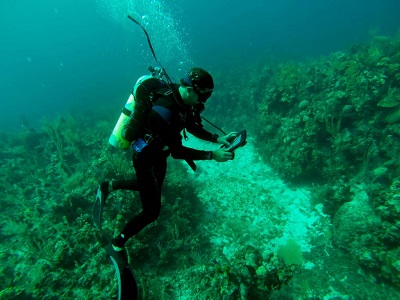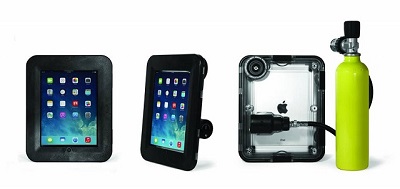Take Your iPad Underwater

By Emily Tripp
.jpg) Last week, Marine Science Today was in the Exumas in the Bahamas, and it was spectacular. Editor and senior writer Emily Tripp had the opportunity to test out a very cool new piece of technology: iDive Housing.
Last week, Marine Science Today was in the Exumas in the Bahamas, and it was spectacular. Editor and senior writer Emily Tripp had the opportunity to test out a very cool new piece of technology: iDive Housing.
Developed by Dr. Michael Berumen, marine biology researcher and professor at the King Abdullah University of Science and Technology (KAUST), iDive housing keeps your iPad safe and fully functional underwater.
After 15 years of research, Dr. Berumen became frustrated with his only method of data collection. While diving, most researchers manually record data with a pencil and special waterproof paper. Then, they spend hours back in the lab copying that data into spreadsheets. There are a few problems here. Manually recording findings underwater is perfectly reliable, but what if your handwriting is messy? What if your paper gets smudged or, worse, what if it gets lost? All that data would be gone for good.
Then there’s the problem with copying the information from the paper into the computer. What if you can’t read one or two lines? What if someone else is doing it for you and they misread your markings? Plus, it takes hours and hours of time that could be better spent progressing the research.
 What if, instead, you could just enter your findings directly into your iPad where they can be saved automatically? The problem is that most underwater cases leave the touchscreen unusable because the screen can’t differentiate between the conductivity of the water and your finger. Plus, these cases would never be able to withstand the crushing pressure of the ocean depths. Dr. Berumen set out to solve this problem.
What if, instead, you could just enter your findings directly into your iPad where they can be saved automatically? The problem is that most underwater cases leave the touchscreen unusable because the screen can’t differentiate between the conductivity of the water and your finger. Plus, these cases would never be able to withstand the crushing pressure of the ocean depths. Dr. Berumen set out to solve this problem.
During a series of (potentially risky and expensive) experiments with his iPad, a ziplock bag, and a bathtub, Dr. Berumen confirmed that the touchscreen will work underwater if there’s a layer of air above the screen. Seven or eight slightly-more-sophisticated models later, iDive emerged as the first fully functioning touchscreen housing.
Developed with the help of Watershot Inc., a product engineering firm known for its expertise in designing and developing products for underwater use, the case has a flexible membrane over the screen with a pressure management system that allows the diver to maintain a layer of air between the screen and the membrane, saving the iPad from the potentially crushing pressure while allowing the diver to have full use of the touchscreen. It’s been tested up to 100 meters, which, for the average diver, is more than deep enough.
 From saving researchers from hours of data-copying to improving the quality and reliability of citizen science data, iDive has the potential to change the course of marine science research. The possible uses aren’t limited to research, though. You can listen to music underwater; you can map out your dive, save it as a PDF, and pull it up while you’re underwater; you can use identification guides to learn more about the marine life you’re swimming with; and you can take pictures (like the one below, taken with an iPad) of all your underwater adventures. The possibilities are nearly endless.
From saving researchers from hours of data-copying to improving the quality and reliability of citizen science data, iDive has the potential to change the course of marine science research. The possible uses aren’t limited to research, though. You can listen to music underwater; you can map out your dive, save it as a PDF, and pull it up while you’re underwater; you can use identification guides to learn more about the marine life you’re swimming with; and you can take pictures (like the one below, taken with an iPad) of all your underwater adventures. The possibilities are nearly endless.
.jpg) Over the next few weeks, we will be exploring some of those options and we want to hear from you! If you could take your iPad underwater, what would you do with it? Are there apps you would like to use?
Over the next few weeks, we will be exploring some of those options and we want to hear from you! If you could take your iPad underwater, what would you do with it? Are there apps you would like to use?
Emily Tripp is the publisher and editor of MarineScienceToday.com, an online magazine about what's in, on, and around the oceans. She holds marine science and biology degrees from the University of Miami's Rosenstiel School of Marine and Atmospheric Science.
